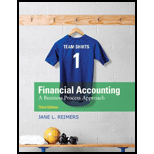
Financial Accounting
3rd Edition
ISBN: 9780133791129
Author: Jane L. Reimers
Publisher: Pearson Higher Ed
expand_more
expand_more
format_list_bulleted
Concept explainers
Question
Chapter 8, Problem 1YT
To determine
Show the effect of issuance of common stock in the
Expert Solution & Answer
Explanation of Solution
The amount of cash received in excess of par value would be recorded as additional paid in capital.

Want to see more full solutions like this?
Subscribe now to access step-by-step solutions to millions of textbook problems written by subject matter experts!
Students have asked these similar questions
PLEASE HELP! NOTICE. THERE ARE FIVE CELLS ON THE LEFT SIDE TO FILL. THE DROPDOWN SHOWS THE OPTIONS FOR THESE CELLS.
Calm Ltd has the following data relating tò two investment projects, only one of which mayb e s e l e c t e d :The cost of capital is 10 per cent, and depreciation is calculated using straight line method.a . Calculate for each of the project:i. Average annual accounting rate of return on average capital investedi i . Net Present Valuei l l . I n t e r n a l R a t e o f Returnb. Discuss the relative merits of the methods of evaluation mentioned above in (a).Q.4a . In the context of process costing, discuss the following concepts briefly, i . Equivalent unitsNormal lossill. Abnormal lossi v. Joint productsV . By productsb . Discuss the different types of standard costing and objectives of standard costing.
Please help me correct the wrong answers:
Chapter 8 Solutions
Financial Accounting
Ch. 8 - Prob. 1YTCh. 8 - Prob. 2YTCh. 8 - Prob. 3YTCh. 8 - Prob. 4YTCh. 8 - 1. Compare a stock split and a stock dividend. 2....Ch. 8 - Prob. 6YTCh. 8 - Prob. 1QCh. 8 - Prob. 2QCh. 8 - Prob. 3QCh. 8 - Prob. 4Q
Ch. 8 - Prob. 5QCh. 8 - Prob. 6QCh. 8 - Prob. 7QCh. 8 - Prob. 8QCh. 8 - Prob. 9QCh. 8 - Prob. 10QCh. 8 - Prob. 11QCh. 8 - Would treasury stock be considered authorized,...Ch. 8 - Prob. 13QCh. 8 - Prob. 14QCh. 8 - Prob. 15QCh. 8 - What are the two sections of the shareholders...Ch. 8 - Prob. 17QCh. 8 - Prob. 18QCh. 8 - Prob. 19QCh. 8 - Prob. 1MCQCh. 8 - Prob. 2MCQCh. 8 - Treasury stock is a. a companys own stock that it...Ch. 8 - Prob. 4MCQCh. 8 - Prob. 5MCQCh. 8 - Prob. 6MCQCh. 8 - The number of shares of stock designated as issued...Ch. 8 - Prob. 8MCQCh. 8 - Prob. 9MCQCh. 8 - Prob. 10MCQCh. 8 - Prob. 1SEACh. 8 - Prob. 2SEACh. 8 - Prob. 3SEACh. 8 - Prob. 4SEACh. 8 - Prob. 5SEACh. 8 - Prob. 6SEACh. 8 - Prob. 7SEACh. 8 - Prob. 8SEACh. 8 - Prob. 9SEACh. 8 - Calculate retained earnings balance. (LO 5)....Ch. 8 - Prob. 11SEACh. 8 - Prob. 12SEBCh. 8 - Prob. 13SEBCh. 8 - Prob. 14SEBCh. 8 - Prob. 15SEBCh. 8 - Prob. 16SEBCh. 8 - Prob. 17SEBCh. 8 - Prob. 18SEBCh. 8 - Prob. 19SEBCh. 8 - Prob. 20SEBCh. 8 - Prob. 21SEBCh. 8 - Prob. 22SEBCh. 8 - Prob. 23EACh. 8 - Prob. 24EACh. 8 - Prob. 25EACh. 8 - Prob. 26EACh. 8 - Prob. 27EACh. 8 - Prob. 28EACh. 8 - Prob. 29EACh. 8 - Prob. 30EACh. 8 - Prob. 31EACh. 8 - Analyze equity accounts. (LO 1, 2, 3, 5). The...Ch. 8 - Prob. 33EACh. 8 - Prob. 34EACh. 8 - Prob. 35EACh. 8 - Prob. 36EACh. 8 - Prob. 37EACh. 8 - Prob. 38EACh. 8 - Prob. 39EBCh. 8 - Prob. 40EBCh. 8 - Prob. 41EBCh. 8 - Prob. 42EBCh. 8 - Prob. 43EBCh. 8 - Prob. 44EBCh. 8 - Prob. 45EBCh. 8 - Prob. 46EBCh. 8 - Prob. 47EBCh. 8 - Prob. 48EBCh. 8 - Prob. 49EBCh. 8 - Prob. 50EBCh. 8 - Prob. 51EBCh. 8 - Prob. 52EBCh. 8 - Prob. 53EBCh. 8 - Prob. 54EBCh. 8 - Prob. 55PACh. 8 - Prob. 56PACh. 8 - Prob. 57PACh. 8 - Prob. 58PACh. 8 - Prob. 59PACh. 8 - Prob. 60PACh. 8 - Prob. 61PACh. 8 - Prob. 62PACh. 8 - Prob. 63PBCh. 8 - Prob. 64PBCh. 8 - Prob. 65PBCh. 8 - Prob. 66PBCh. 8 - Prob. 67PBCh. 8 - Prob. 68PBCh. 8 - Prob. 69PBCh. 8 - Prob. 70PBCh. 8 - Prob. 1FSACh. 8 - Prob. 2FSACh. 8 - Prob. 3FSACh. 8 - Prob. 1CTPCh. 8 - Prob. 2CTPCh. 8 - Prob. 1IECh. 8 - Prob. 2IECh. 8 - Prob. 3IECh. 8 - Prob. 4IECh. 8 - Prob. 5IE
Knowledge Booster
Learn more about
Need a deep-dive on the concept behind this application? Look no further. Learn more about this topic, accounting and related others by exploring similar questions and additional content below.Similar questions
arrow_back_ios
SEE MORE QUESTIONS
arrow_forward_ios
Recommended textbooks for you

 AccountingAccountingISBN:9781337272094Author:WARREN, Carl S., Reeve, James M., Duchac, Jonathan E.Publisher:Cengage Learning,
AccountingAccountingISBN:9781337272094Author:WARREN, Carl S., Reeve, James M., Duchac, Jonathan E.Publisher:Cengage Learning, Accounting Information SystemsAccountingISBN:9781337619202Author:Hall, James A.Publisher:Cengage Learning,
Accounting Information SystemsAccountingISBN:9781337619202Author:Hall, James A.Publisher:Cengage Learning, Horngren's Cost Accounting: A Managerial Emphasis...AccountingISBN:9780134475585Author:Srikant M. Datar, Madhav V. RajanPublisher:PEARSON
Horngren's Cost Accounting: A Managerial Emphasis...AccountingISBN:9780134475585Author:Srikant M. Datar, Madhav V. RajanPublisher:PEARSON Intermediate AccountingAccountingISBN:9781259722660Author:J. David Spiceland, Mark W. Nelson, Wayne M ThomasPublisher:McGraw-Hill Education
Intermediate AccountingAccountingISBN:9781259722660Author:J. David Spiceland, Mark W. Nelson, Wayne M ThomasPublisher:McGraw-Hill Education Financial and Managerial AccountingAccountingISBN:9781259726705Author:John J Wild, Ken W. Shaw, Barbara Chiappetta Fundamental Accounting PrinciplesPublisher:McGraw-Hill Education
Financial and Managerial AccountingAccountingISBN:9781259726705Author:John J Wild, Ken W. Shaw, Barbara Chiappetta Fundamental Accounting PrinciplesPublisher:McGraw-Hill Education


Accounting
Accounting
ISBN:9781337272094
Author:WARREN, Carl S., Reeve, James M., Duchac, Jonathan E.
Publisher:Cengage Learning,

Accounting Information Systems
Accounting
ISBN:9781337619202
Author:Hall, James A.
Publisher:Cengage Learning,

Horngren's Cost Accounting: A Managerial Emphasis...
Accounting
ISBN:9780134475585
Author:Srikant M. Datar, Madhav V. Rajan
Publisher:PEARSON

Intermediate Accounting
Accounting
ISBN:9781259722660
Author:J. David Spiceland, Mark W. Nelson, Wayne M Thomas
Publisher:McGraw-Hill Education

Financial and Managerial Accounting
Accounting
ISBN:9781259726705
Author:John J Wild, Ken W. Shaw, Barbara Chiappetta Fundamental Accounting Principles
Publisher:McGraw-Hill Education
Stockholders Equity: How to Calculate?; Author: Accounting University;https://www.youtube.com/watch?v=2jZk1T5GIlw;License: Standard Youtube License